I was going through the section of pipelining from the text Computer Organization [5e] by Hamacher et. al.. There I came across a situation which the authors claim causes data hazard.
The situation is shown below:
For example, stage
Ein the four-stage pipeline of Figure 8.2b is responsible for arithmetic and logic operations, and one clock cycle is assigned for this task. Although this may be sufficient for most operations, some operations, such as divide, may require more time to complete. Figure 8.3 shows an example in which the operation specified in instructionI2requires three cycles to complete, from cycle4through cycle6. Thus, in cycles5and6, the Write stage must be told to do nothing, because it has no data to work with. †: Meanwhile, the information in bufferB2must remain intact until the Execute stage has completed its operation. This means that stage2and, in turn, stage1are blocked from accepting new instructions because the information inB1cannot be overwritten. Thus, stepsD4andF5must be postponed as shown.
... Any condition that causes the pipeline to stall is called a hazard. We have just seen an example of a data hazard. A data hazard is any condition in which either the source or the destination operands of an instruction are not available at the time expected in the pipeline.
In the example above, the authors assume that a data hazard has occurred, and two stall cycles are introduced into the pipeline. The main reason that they give for this data hazard is that, since the execute phase requires 2 more cycles than the usual need for instruction 2, so the data on which the write back stage should work has to wait for 2 cycles...
But I am having a little difficulty in accepting this analysis. Usually, the books give examples of data hazards in situations, where there is data dependency (the usual RAW, WAR, etc..). But here there is no such thing. And I thought this to be a structural hazard assuming that I2 cannot use the EX stage as I1 is using it.
Moreover, the text assumes that there is no queuing of the results of the stages in the buffer. Clear from the statement marked with †, Meanwhile, the information in the buffer..., (where there is a little flaw as well, because, if no queuing is there, then the output of D3 in cycle 4 shall overwrite the value in buffer B2 on which the EX stage is working, a contradiction to their own assumption).
I thought that the stalls are introduced due to this no queuing condition... and structural hazard, and if things are properly managed as shown below, no stalls shall be there.
This is what I assume:
- I assume that the execute stage has more than one separate functional units (e.g. one where calculations of instruction
1are performed. [basic ALU requiring 1 cycle duration], one for integer division, another for integer multiplication etc.) [So structural hazard is out of the way now.] - I also assume that the pipeline buffers can store the results produced in the stages in a queue. [So that the problem in statement marked with † is no longer there.]
This being said, the situation is now as follows:
However hard I tried with the assumptions, I could not remove the bubbles shown in blue. [Even if queuing is assumed in buffers, the buffers cannot give the result out of order, so those stalls remain].
With this exercise of mine, I feel that the example shown in the text is indeed a hazard and that too data hazard (even though there was no data dependencies ?), as in my exercise there was no chance of structural hazard...
Am I correct?
